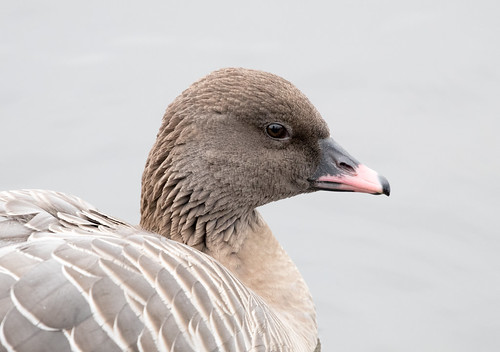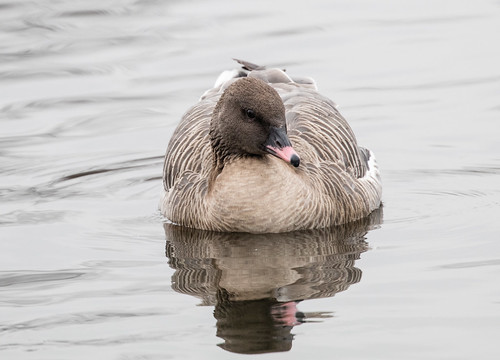
Whenever I go to New York City, people from more rural areas—which, really, is just about everywhere I go—seem to think that of course there won't be any interesting birds in the Big Apple. In recent years, I’ve been to movies, gone on top of the Empire State Building, spent time wandering around Manhattan, and attended an off-Broadway play when I've been in New York, but I’ve also done my share of birding. As a harbor city, it’s not at all hard to find good coastline birds in New York, and it obviously abounds in urban birds and birds that can manage to eke out an existence in small urban parks. But it also has some genuinely quality habitat as fine as anything we have in Minnesota or Wisconsin, some with the added advantage of saltwater.
On Friday, I needed to do something quiet and contemplative, and happened to be visiting my daughter in the Big Apple. A Pink-footed Goose had been seen at a small city park on Long Island starting on November first. It was still being reported as late as January 16—the last date anyone had reported from Arthur J. Hendrickson Park—so I figured it was worth a shot and that a literal wild goose chase would be as good a way as any to spend the day.
So in the morning, I walked a few blocks from my daughter’s apartment in Brooklyn to catch one of the commuter trains to Long Island. I’ve been using New York’s subway system for a long time, and get around pretty well as long as I write down all the subway lines that stop in my daughter’s neighborhood and pay attention to when I need a local vs. an express to make a connection or get off at the right place. I was fearful that taking a commuter train would be more complicated. As it turned out, though, it was quite simple. To buy a ticket in the first place, I did have to know which of the Long Island trains I needed—the Far Rockaway—and which stop I’d be getting off at—Valley Stream—and then I had to pay attention to signs and schedule boards to make sure I got on the right train and got off at the right stop. A couple of passengers on my train found out too late, from the conductor taking their tickets, that they were each on the wrong train. The conductor told them each where to get off to catch a connecting train, but one even went past the stop she needed and was going to have to pay an additional fare to turn around. I guess when you don’t know what you’re doing, it’s better to realize it and be extra careful about asking directions than to not realize you don’t know what you’re doing in the first place.
Being directionally impaired, I depend on Google Maps on my smart phone a lot. The Google Map Lady wanted me to walk along one street, but I could see on the directions screen a short detour that would bring me along a brook, so I went that way. It turned out to be a wise decision—one male Hooded Merganser was hanging out with a large group of Mallards, and he gave me some of the best merganser photos I’ve ever taken.
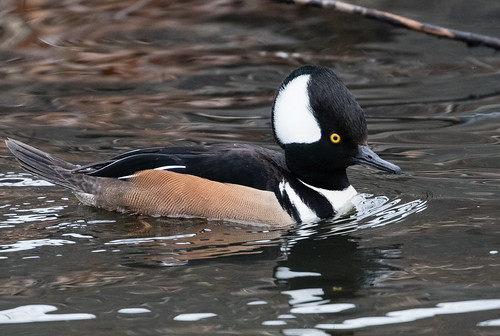
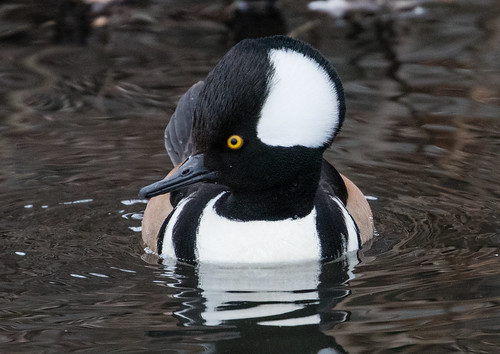
Arthur J. Hendrickson Park is a small urban park surrounding a small urban lake—what Jethro Bodine or Elly May Clampett might have legitimately called a cement pond. It reminded me a bit of Lake Merritt, a large tidal lagoon in downtown Oakland, California, which happens to be historically significant as the United States' first official wildlife refuge, designated in 1870. (The Wichita Mountains Wildlife Refuge, established in 1901, is the first wildlife refuge to be part of the National Wildlife Refuge system.)
I arrived on the west side of the park, and walked past a building and some tennis courts to reach the lake. All the waterfowl were loafing and snoozing in the water along the east edge, in large clumps. The main birds were Mallards and Canada Geese, and as I walked along the length of the lake on the far side from them, I counted them as accurately as possible—120 Mallards and 360 Canada Geese. As I counted, I looked for outliers—there were 8 American Black Ducks, a pair of Northern Shovelers, another male Hooded Merganser, and also one goose that looked suspiciously good, but I’d never have dared count it from that distance with my 8x binoculars. Fortunately, the geese weren’t going anywhere, so I kept walking and counting until I rounded the long, narrow lake and started looking at the birds now on the close side of the lake.
Like all urban parks, Arthur J. Hendrickson Park has a lot of foot and bike traffic, and the birds who live there are as used to people wandering by as wilder wildlife is when a deer passes through. The geese kept snoozing as I walked past the first group of about a hundred. At that point, I encountered a sweet retired couple from the neighborhood taking a stroll, and they asked me if I'd found what I was looking for—my long camera lens and binoculars were the giveaways that I was there for a reason. I told them I was looking for a rare bird—a Pink-footed Goose that belonged across the ocean.
They were intrigued, looking at the mass of geese out there, and asked how I could possibly pick out one individual rarity among so many. But right at that very moment, I was picking out the outlier—that one Pink-footed Goose happened to be at the water’s edge right below us! I showed how its color and pattern were different, and how it had a uniformly brown head instead of the black-and-white head of the Canada Geese. They seemed excited to see it, and I was thrilled to share my happy experience with someone.
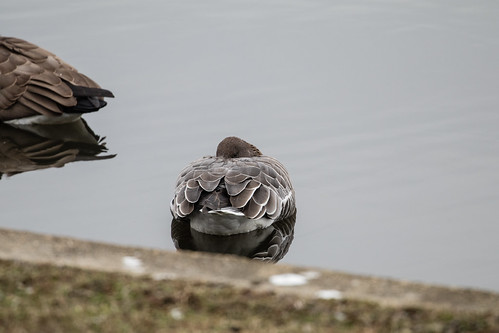
I first spotted the goose about 11:22 am, and decided I should stay with this lovely and welcome avian immigrant through 12:01 pm. The weather was pleasantly cool but the sky was rather bleak, so my photos are duller than I’d like, but I was close enough, and the light decent enough to get reasonably good pictures—I took a LOT!

A nearby Methodist church’s Westminster chimes went off at noon—bright and ringing—but the bell that tolled the hour was lower pitched, giving a most somber reminder that after that moment, human immigrants to our shores would not be as welcome as this avian one.
I thought of this land that I love—the country that often falls short but has proudly stood up for liberty and justice for all, for protection of vulnerable wildlife, and for maintaining and restoring clean air and water for all of us—this country that has inspired so many other nations with its progressive ideals.
And I thought of my favorite president of all, Ulysses S. Grant. When he was traveling in Germany after his presidency, Bismark congratulated him on saving the Union. Grant pointed out that America’s achievement was to “Not only save the Union, but destroy slavery.”
Grant modestly dissented when one German consul claimed that Grant had singlehandedly saved the nation. “If our country could be saved or ruined by the efforts of any one man, we should not have a country.” Grant’s reassuring words gave me hope as I gave the Pink-footed Goose a sad backward glance and started walking back to the train station and a new America.
